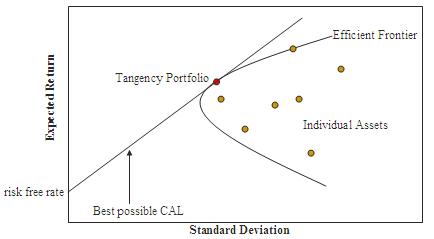Thursday, 20 March 2014
Fallacy of the week: higher risk implies higher return
I remember a conversation at my local bank branch when I wanted to open a small securities account. Their financial advisor asked me what assets I wanted to invest in and offered advice in allocating the portfolio. Most of what she said sounded extremely sensible, but that was mainly because she was a good saleswoman and I hadn't prepared myself well for the meeting.
One part of her advice was that I could choose to invest in equity mutual funds or individual stocks. While the latter would be much more risky, it would also offer the chance of a much higher return.
Over the years, I have heard this argument time and again. In it's general form, it goes somewhat like this:
"Here's an investment opportunity. It's quite risky, but as you know, people who only accept low risk only get low returns. So if you want a high return, invest now!"
The argument sounds somewhat intuitive to me. After all, it's just a description of risk premia, right? Markets reward high risk strategies with high returns. But just as this argument is intuitive, it is also dangerously wrong. Why? Because if you believe it, you will put your hard-earned savings at unnecessary risk by not sufficiently diversifying your portfolio.
This post does not contain any deep thoughts about economics. But I write it because my personal observation suggests that many small individual investors run more or less unconsciously into this simple fallacy.
To illustrate it a little more, suppose you are indeed a small individual investor (if you bother to read this far then you almost certainly are). You can invest money into two stocks, Coca-Cola and Pepsi. You expect both to yield an average return of 4% over the next year. But being stocks, they're both risky: You think that 90% of the time, the return of each stock will fluctuate between 0% and 8%. Now, you could invest all your money in either Coke or Pepsi. Or you can invest half the money in each. If you do the latter, your return will be within 0% and 8% less than 90% of the time, because in order for the return to fall below 0% you need both companies to do badly instead of just one. So this reduces your risk. And what's your expected return? It's the average of 4% and 4%, in other words... still 4%!
You can go ahead and go stockpicking here, and expose yourself to higher risk. Will it earn you higher returns? Sometimes, but on average: not at all. So sober up and stop gambling with your savings.
And what I say does not only apply to stockpicking. It also applies to pouring a lot of money into the purchase of real estate, or putting it all into an equity stake of that tech/green/tax-evading start-up company. Yes, this is very risky because if that one asset implodes your money is gone. But at the same time, you will often also not get a higher return for taking that risk.
Here's a slightly more technical version of the argument. Asset pricing theory tells us that it is not variance which markets compensate with high returns, but covariance with the discount factor: $$ E[R_i]=R_0 (1 - Cov(Q,R_i))$$ where \(R_0\) is the (hypothetical, if you wish) risk-free rate. In the special case of quadratic utility of an investor with a fixed sum to invest over one period, we get the CAPM formula $$ E[R_i]-R_0=\beta_i (E[R^m]-R_0) \text{ with }\beta_i=\frac{Cov(R^m,R_i)}{Var(R^m)}$$ where \( R^m\) is the return on the "market portfolio", the asset allocation of the marginal investor. Now let's rewrite the return on security i as \( R_i = ( R_i - \beta_i R^m) + \beta_i R^m = R_i^d + R_i^{nd}\). Clearly we have $$ E[R^d_i]=R_0 \text{ and } E[R^{nd}_i]=E[R_i]$$ So the market compensates only the risk of the non-diversifiable component \(R^{nd}_i\), but not that of the diversifiable component \(R^d_i\): We have $$\beta_i=\frac{Var[R^{nd}_i]}{Var[R^m]} \neq \frac{Var[R_i]}{Var[R^m]}$$ The fallacy is to put an "=" sign in the last line. Do you think nobody in his right mind would make that mistake? Well, the German Wikipedia does, stating that \(\beta_i \) would be the relative volatility of an asset relative to the market... I would bet that a lot of people read this or similar expositions and then go on picking their favourite stocks instead of just buying the bloody ETF.
Now you might say: "Wait, I still want to buy Google instead of Apple stock because I know that that company is better. I got business sense!" Except this is not about business sense. This is not about knowing which company has a good business model and which doesn't. This is about figuring out which securities are under- or overvalued relative to where they will be in the future. Can you analyse this while working a full-time non-finance job and taking care of the kids on the weekends?
There is one potent argument against diversification of course: costs. Actively managed mutual funds take hefty management fees, so with that strategy you might really need to trade off significantly lower returns in exchange for lower risk. With the rise of ETFs and online brokerage accounts, however, it is nowadays very cheap to buy diversified securities or just build your own diversified portfolio. The case is probably less clear for investing in real estate or non-public companies. Real estate and private equity funds for small individual investors do exist, but here the fees are still pretty high. Still, just because it is costly for you to diversify a risky investment strategy doesn't mean that it is also costly for more sophisticated investors. And if these guys are pricing your strategy, then you will still not earn higher returns by taking higher risk.
Subscribe to:
Post Comments (Atom)

No comments:
Post a Comment